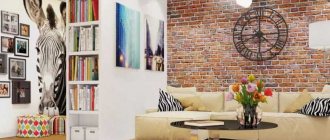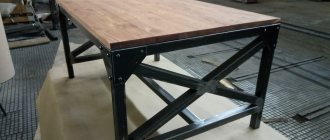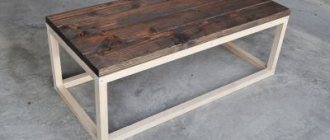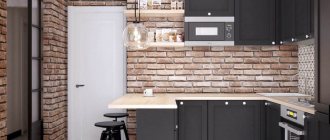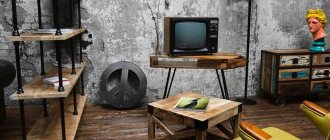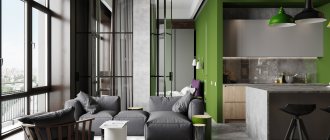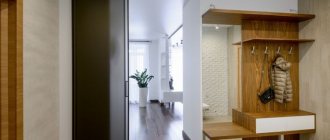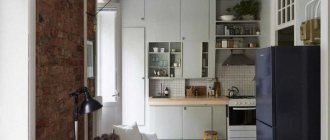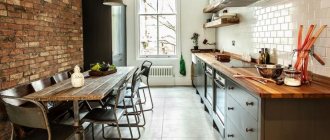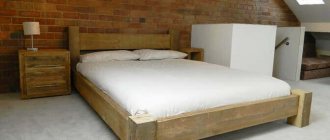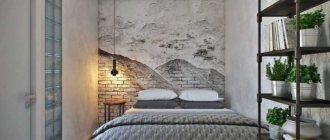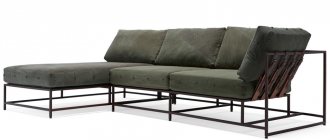The loft style in architecture appeared recently, but has already become popular. The main feature of this style is the presence of a brick wall in the building. At least, this is how the development of the loft style began. The brickwork was left exposed in the room, creating a certain charm of the interior decoration. This style began to develop in America, and since the 60s of the last century it has become popular in Europe. Old industrial buildings and attics were converted into commercial and domestic premises.
Peculiarities
In this style, the rule is followed: the interior space should be as free as possible, without frills, without partitions, that is, in the design you need to know when to stop.
The room is not divided into zones by structures. It is very important to preserve old pipes and bare brickwork without plastering or painting.
Mandatory conditions for industrial style:
- Compliance with strict geometric lines.
- Clear, simple forms.
- Free, transparent space.
- Decor in discreet, laconic details.
- The simple decor is complemented by pipes.
- Very simple rectangular window shapes.
- The door openings are made simple without any special decorations.
- Whole colors are often used for decoration.
Application in the construction of bricks in the loft style.
Nowadays, this style is used not only in buildings with high ceilings and a huge area; an untreated wall made of old brick looks original. It is used to decorate cafes and restaurants. Artists, poets, and performers like to gather in such cafes.
Decor
The formation of the interior does not end with finishing, installation of cabinets and upholstered furniture. Various decoration items add completeness to the interior. It’s not difficult to do it yourself, but a professional decorator will do it according to all the canons of style.
Wooden decor in the form of a regular shield made of knocked together boards looks very appropriate on a brick wall. For this purpose, they are selected with a pronounced woodiness: knots, sapwood, cracks, aging, etc.
Loft paintings, graffiti, black and white photos, printing on billboards, posters, art and pop posters of past years. Ideally symbolize the loft theme, the lifestyle of people of yesteryear.
Wall decor is created using vintage figured frames from old paintings and mirrors. A combination of a pair of three such objects creates an interesting composition.
A window frame with peeling paint with old glass, a mirror or black and white photos placed in it is a hand-made technique to maintain style.
Loft wall lamps are an important attribute of the brutal character of the interior. Their lampshades are made of tin sheets, and their bases are made of metal parts of mechanisms, machine tools, and pipes. Spotlights, spots and large light bulbs - everything will emphasize the style.
Finishing brick in loft style
The loft style creates a connection between the past and the present. Cleared walls of plaster draw attention to the base of the structure, that is, the brick.
To create a loft style, artificially aged material with an uneven surface is used. Manufacturers have learned to make similar finishing materials in different colors.
The material is being formed. The viscous mass enters the mold, then it is pressed. Excess pieces that do not fit into the mold are cut off, and the resulting brick is removed from the mold in a simple way: the mold is turned over. The formed raw brick is sent for drying. To prevent the wet mass of clay from sticking to the mold, it is sprinkled with sand. Moreover, the color of the sand creates the color of the finished brick itself. To age a brick, it is subjected to special treatment before firing.
Typical brick texture in loft style.
Conventionally, the loft style is divided into the following types:
- A rigid design option is used to create modern forms with an existing room.
- Soft option. For it, certain internal changes are specially selected, developed and specially created.
- A commercial option, when ordinary industrial buildings with a height of five meters are subject to registration. This option is acceptable for decorating business centers and exhibition halls.
- Life is used to organize the comfort and coziness of the home.
On our website there is a good article about finishing work and arrangement of the base of a pile foundation, including finishing bricks.
Industrial style in a living space
Most often, this style is used to decorate fashionable cafes, restaurants, and exhibition halls. And it would seem that the strict loft style is not suitable for decorating apartments and houses - the interior turns out to be too strict and cold. But with the help of certain techniques, a strict design can be diversified, made it warmer, created a cozy atmosphere, and given an enchanting charm.
This became possible thanks to the color range that . In the classical sense, an industrial interior should contain:
- high ceilings,
- a lot of light
- large space.
That is, not every apartment meets these requirements. How can you decorate an ordinary apartment with low ceilings and a small area in this style? For such purposes, a fairly large palette of colors was created.
Different tones of bricks in loft style.
You can create a loft style in an apartment or house:
- Using a natural method. It is suitable if the design uses bricks selected from old buildings.
- Using the method of artificial production of “aged bricks”. It is he who will help bring the loft style into apartments or residential buildings.
Using white stone in decoration
When creating a loft style in residential premises, white with various tones of gray is in great demand. The fact is that with the help of a combination of white and gray shades, you can optically expand the boundaries of the room, add light, and create space. For such a project, “aged tiles” can be used:
- white,
- light gray
- silver granite,
- marble,
- dark granite,
- anthracite colors
Using white stone (or white painted brick) in the interior.
By combining light bricks with dark tones, it is not difficult to visually correct the interior parameters. For example, visually expand a narrow room.
Brick walls in the living space create an extraordinary, cozy atmosphere. The white color of masonry is appropriate when creating in residential premises:
- loft style,
- Scandinavian style,
- English style,
- Provence style
Seams
The seams should be treated so that they stand out against the background of the brick wall. The most convenient way to do this is with a chisel. First we go through deepening the top edge, then the bottom. The result is slightly recessed “embroidered” seams, with clearly defined edges of the bricks. There is no need to clean the seams deeply, 2-4 millimeters is enough.
When the seams are cleaned, it doesn’t hurt to go over the entire wall with coarse sandpaper, finally removing all unnecessary material. We thoroughly sweep the wall from dust; a vacuum cleaner will be very useful. Next, the entire wall needs to be primed with deep penetration soil. You need to prime with a brush, penetrating into the most inaccessible recesses in the seams, not forgetting about the brick itself.
Where is it appropriate to use aged stone?
In principle, brickwork will fit organically into any room. The main thing in this case of design is to choose a tile of a suitable color and the correct place for laying it. That is, it will be necessary to take into account that its location will attract attention. This means that you need to provide appropriate furniture.
When it is inappropriate to use a typical loft style, but the soul asks for a brick design, you should pay attention to other similar materials, for example, yellow facing brick.
Decoration in the hallway
You can use “aged masonry” to separate the entrance part of the apartment from the living quarters, or decorate one wall with textured tiles, or you can install a partition from blocks. When there is not much space, you can decorate only a small part of the wall; for example, a place for a hanger lined with “aged tiles” looks original. Another option is to design the place of the dressing table and mirror.
How to use this type of stone in the kitchen
Most often, brickwork plays the role of an “apron”. In this case, it is advisable to use decorative stone with a smooth surface. A stone with such a surface will greatly facilitate the maintenance of the “apron”.
Loft-style kitchen, the walls of which are made of decorative cladding.
Living room decoration
Typically, the living rooms in the house are the largest in area. Therefore, here you can realize larger-scale fantasies such as installing an arch or column, or laying out a wall near which the fireplace is located.
Bedroom
In the bedroom, the wall or only part of it at the head of the bed is usually finished. Sometimes they frame a window or balcony doors. The main thing is not to forget about a sense of proportion, so as not to overload the space with decorative bricks.
Toilet room
Typically, toilet rooms in multi-storey buildings were lined with bricks. Of course, it is not decorative, but using your imagination you can clean and wash the wall, that is, create a decor corner in the loft style.
Brick wall - imitation
The simplest and most budget-friendly option for simulating a brick wall is wallpaper with a brick print. This surface is easy to care for - you can simply wipe it with a damp cloth. The disadvantage is that the surface is unnatural, and the end result does not look very attractive.
Another common option is decorative brick-like stone. The surface of this stone is covered with glaze, so with proper care it will last for a long time. And this coating looks very natural, but in terms of budget this option is very expensive.
The most optimal and beautiful finishing option is an imitation brick wall made of plaster.
Advantages of this method:
- no large financial costs required
- environmental friendliness - the plaster contains no harmful substances
- the space will not decrease - the layer is quite thin
- you can handle it on your own, there is no need to call specialists
Materials and tools:
- bath - for administering the solution
- tile adhesive and plaster
- masking tape
- wide and narrow spatulas
- construction rule and laser level
Methods of interior decoration
Brick has been used in construction for centuries and its presence in the interior is perceived naturally. Bricklaying methods can be produced in various ways:
- Fragmented masonry can only occupy some part of the wall. Typically, fragmentary masonry is used in Scandinavian style design.
- You can use brickwork to create an accent. That is, use masonry to highlight only part of the wall. This part will attract all attention. Usually it is arranged, for example, in the bedroom at the head of the room, or they outline the fireplace.
- Sometimes the entire wall is decorated with brickwork. Most often, this technique is used to create special comfort. This could be a wall in the living room, where the owners receive guests, or it could be a kitchen wall, if it serves as a dining room.
- Brickwork can be paved as a separate architectural element. For example, an arch connecting the hallway and the kitchen, or lay out only a section of the wall next to the aquarium.
- The partitions are made of brickwork.
Combining loft styles for a more impressive finish.
Video description
Learn how to get rid of efflorescence on brickwork by watching this video:
Joining seams
To create a loft wall, the brick needs to be half cleared. Here they use a special tool for jointing - a chisel. This procedure is best done in pairs: one person will measure the seams with a building level, and the second will make passes.
You can use both electric tools like a grinder and a hammer drill, and mechanical ones like a chisel and a hammer.
Important! In order not to damage the neighboring bricks, they begin to break off pieces from the edge of the shaped product.
During work, the seams are cleared to the required depth - 2-4 mm, so that the bricks are clearly distinguishable.
Sanding and priming masonry
After clear cleaning, use a grinding machine or ordinary sandpaper. This operation allows you to make the masonry wall even.
Important! After sanding, you need to clean the surface with a vacuum cleaner or broom. You can also wash the wall with clean water.
The priming process is also used as an intermediate step on the way to painting or stenciling. The surface treated with this composition does not crumble and absorbs paint or varnish well. This allows you to reduce the consumption of basic materials.
Sanding the wall Source ytimg.com
Raw materials for making “aged tiles” and prices
Artificially made bricks for loft style are a very exact copy of old models. They are as close as possible to the natural appearance of the old options, but they contain notes of non-standard techniques. The production technology of such a product involves the use of manual labor. However, modern technologies have made it possible to mechanize the processes of decorating bricks, so that such a product becomes affordable for lovers of unusual interior design.
For example, white brick. If gypsum was used for its production, then its cost will be approximately 700 rubles, with dimensions equal to 250-260x70x15 and the manufacturer is Russian. But if the tiles are made using concrete with the same parameters and from a Russian manufacturer, the cost will double.
Do not confuse white loft brick and white sand-lime brick - these are different types of building materials.
It should be noted that the brick for this design may be truly old, which was obtained during dismantling of old buildings. Dismantling is done manually, then the bricks are cleaned of any remaining mortar. Then the bricks go through a washing process. The clean and dried product is then carefully placed in boxes.
Often the desired look is given to ordinary brick only by visually “aging” it.
Second option. The company produces brick tiles followed by an aging process. This product is attractive; you can choose the appropriate sizes, because they can be:
- length 250-270 mm,
- width 65-70 mm,
- thickness 25-50 mm
Wiring
Wiring fits perfectly in horizontal seams; to do this, you first need to clean the seams deeper than the others. The wire is laid between the bricks and covered in the same way as the rest. With vertical sections of wiring it is more complicated - the wire is brought to the corner in a horizontal seam, and then it is simply run along the corner or inserted into a prepared narrow groove.
Sockets and switches are installed both hidden and surface-mounted, I think there will be no problems with this.
